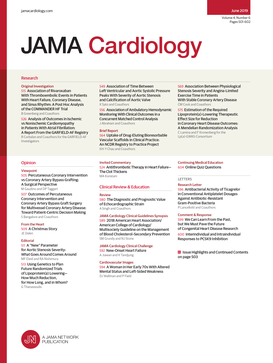超声心动图中三尖瓣反流的自动深度学习表型分析
IF 14.8
1区 医学
Q1 CARDIAC & CARDIOVASCULAR SYSTEMS
引用次数: 0
摘要
重要性准确评估三尖瓣反流(TR)对识别和风险分层是必要的。目的设计一种用于彩色多普勒超声心动图视频识别和TR严重程度表征的深度学习计算机视觉工作流程。设计、设置和参与者使用雪松-西奈医学中心(CSMC) 2011年至2021年间的47312项研究(2079 898个视频)开发了一个自动化深度学习工作流。数据分析于2024年进行。该管道在2022年从CSMC获得的2462项研究(108138个视频)的时间上不同的测试集和从斯坦福医疗(SHC)获得的5549项研究(278377个视频)的地理上不同的队列中进行了测试。培训和验证队列包含2011年至2021年间在CSMC接受治疗的3708名患者的数据。患者的选择是基于TR严重程度级别的均等,没有基于其他临床或人口统计学特征的排除标准。2022年CSMC测试队列和SHC测试队列分别包含来自2170名患者和5014名患者的研究。深度学习计算机视觉模型。主要结果和测量方法:主要结果是接受者工作特征曲线下面积(AUC)、彩色多普勒识别三尖瓣顶端4室(A4C)视频的灵敏度和特异性,以及识别中度至重度或重度tr研究的AUC。结果在CSMC测试数据集中,视图分类器的AUC为1.000 (95% CI,0.999-1.000), 2462项研究中有2410项通过彩色多普勒识别出至少1个三尖瓣A4C视频,灵敏度为0.975 (95% CI, 0.968-0.982),特异性为1.000 (95% CI, 1.000-1.000)。在CSMC试验队列中,中、重度TR的AUC为0.928 (95% CI, 0.913-0.943),重度TR的AUC为0.956 (95% CI, 0.940-0.969)。在SHC队列中,视图分类器在5549项研究中的5268项中正确识别了至少1个TR彩色多普勒视频,导致AUC为0.999 (95% CI, 0.998-0.999),灵敏度为0.949 (95% CI, 0.944-0.955),特异性为0.999 (95% CI, 0.999-0.999)。人工智能模型检测中重度TR的AUC为0.951 (95% CI, 0.938 ~ 0.962),重度TR的AUC为0.980 (95% CI, 0.966 ~ 0.988)。结论和相关性在本研究中,开发了一种自动化管道来识别具有优异性能的临床意义的TR。该项目具有开源代码和权重,可以作为未来超声心动图人工智能辅助工作流程前瞻性评估的基础。本文章由计算机程序翻译,如有差异,请以英文原文为准。
Automated Deep Learning Phenotyping of Tricuspid Regurgitation in Echocardiography
ImportanceAccurate assessment of tricuspid regurgitation (TR) is necessary for identification and risk stratification.ObjectiveTo design a deep learning computer vision workflow for identifying color Doppler echocardiogram videos and characterizing TR severity.Design, Setting, and ParticipantsAn automated deep learning workflow was developed using 47 312 studies (2 079 898 videos) from Cedars-Sinai Medical Center (CSMC) between 2011 and 2021. Data analysis was performed in 2024. The pipeline was tested on a temporally distinct test set of 2462 studies (108 138 videos) obtained in 2022 at CSMC and a geographically distinct cohort of 5549 studies (278 377 videos) from Stanford Healthcare (SHC). Training and validation cohorts contained data from 31 708 patients at CSMC receiving care between 2011 and 2021. Patients were chosen for parity across TR severity classes, with no exclusion criteria based on other clinical or demographic characteristics. The 2022 CSMC test cohort and SHC test cohorts contained studies from 2170 patients and 5014 patients, respectively.ExposureDeep learning computer vision model.Main Outcomes and MeasuresThe main outcomes were area under the receiver operating characteristic curve (AUC), sensitivity, and specificity in identifying apical 4-chamber (A4C) videos with color Doppler across the tricuspid valve and AUC in identifying studies with moderate to severe or severe TR.ResultsIn the CSMC test dataset, the view classifier demonstrated an AUC of 1.000 (95% CI, 0.999-1.000) and identified at least 1 A4C video with color Doppler across the tricuspid valve in 2410 of 2462 studies with a sensitivity of 0.975 (95% CI, 0.968-0.982) and a specificity of 1.000 (95% CI, 1.000-1.000). In the CSMC test cohort, moderate or severe TR was detected with an AUC of 0.928 (95% CI, 0.913-0.943), and severe TR was detected with an AUC of 0.956 (95% CI, 0.940-0.969). In the SHC cohort, the view classifier correctly identified at least 1 TR color Doppler video in 5268 of the 5549 studies, resulting in an AUC of 0.999 (95% CI, 0.998-0.999), a sensitivity of 0.949 (95% CI, 0.944-0.955), and a specificity of 0.999 (95% CI, 0.999-0.999). The artificial intelligence model detected moderate or severe TR with an AUC of 0.951 (95% CI, 0.938-0.962) and severe TR with an AUC of 0.980 (95% CI, 0.966-0.988).Conclusions and RelevanceIn this study, an automated pipeline was developed to identify clinically significant TR with excellent performance. With open-source code and weights, this project can serve as the foundation for future prospective evaluation of artificial intelligence–assisted workflows in echocardiography.
求助全文
通过发布文献求助,成功后即可免费获取论文全文。
去求助
来源期刊

JAMA cardiology
Medicine-Cardiology and Cardiovascular Medicine
CiteScore
45.80
自引率
1.70%
发文量
264
期刊介绍:
JAMA Cardiology, an international peer-reviewed journal, serves as the premier publication for clinical investigators, clinicians, and trainees in cardiovascular medicine worldwide. As a member of the JAMA Network, it aligns with a consortium of peer-reviewed general medical and specialty publications.
Published online weekly, every Wednesday, and in 12 print/online issues annually, JAMA Cardiology attracts over 4.3 million annual article views and downloads. Research articles become freely accessible online 12 months post-publication without any author fees. Moreover, the online version is readily accessible to institutions in developing countries through the World Health Organization's HINARI program.
Positioned at the intersection of clinical investigation, actionable clinical science, and clinical practice, JAMA Cardiology prioritizes traditional and evolving cardiovascular medicine, alongside evidence-based health policy. It places particular emphasis on health equity, especially when grounded in original science, as a top editorial priority.
 求助内容:
求助内容: 应助结果提醒方式:
应助结果提醒方式:


